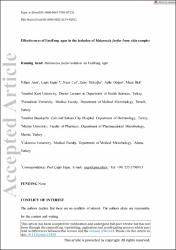Effectiveness of FastFung agar in the isolation of Malassezia furfur from skin samples
Citation
Atsü, N., Ergin, Ç., Caf, N., Türkoğlu, Z., Döğen, A., & İlkit, M. (2022). Effectiveness of FastFung agar in the isolation of Malassezia furfur from skin samples. Mycoses, 10.1111/myc.13450. Advance online publication. https://doi.org/10.1111/myc.13450Abstract
Abstract
Background: Lipophilic basidiomycetous yeasts of the Malassezia genus can cause various skin diseases, such as seborrheic dermatitis, pityriasis versicolor, folliculitis and atopic dermatitis, and even life-threatening fungemia in newborns and immunocompromised individuals. Routine mycological media used in clinical practice do not contain sufficient lipid ingredients required for the growth of Malassezia species. A recently developed medium, FastFung agar, is promising for culturing fastidious fungal species.
Methods: In this study, we compared FastFung agar and mDixon agar for culturing Malassezia species from nasolabial fold and retroauricular specimens of 83 healthy individuals and 187 and 57 patients with acne vulgaris and seborrheic dermatitis, respectively.
Results: Malassezia species were identified using conventional tests and matrix-assisted laser desorption/ionization mass spectrometry. In total, 96 of 654 samples (14.6%) contained Malassezia species. The total isolation rate was significantly higher in patients with seborrheic dermatitis (40.4%) than in healthy volunteers (21.7%; p < 0.05), and the rate of M. furfur isolation was significantly higher for patients with acne vulgaris (13.9%) and seborrheic dermatitis (24.6%) than for healthy individuals (1.5%; p < 0.05). FastFung agar was superior to mDixon agar in M. furfur isolation (p = 0.004) but showed similar performance in the case of non-M. furfur species (p > 0.05). Among cultured Malassezia species, perfect agreement between mDixon agar and FastFung agar was found only for M. globosa (κ = 0.90).
Conclusion: Our results indicate that FastFung agar favors the growth of Malassezia species and should be useful in clinical mycology laboratories.


















